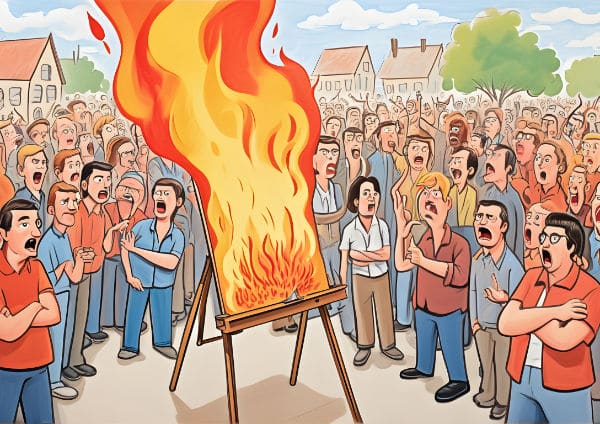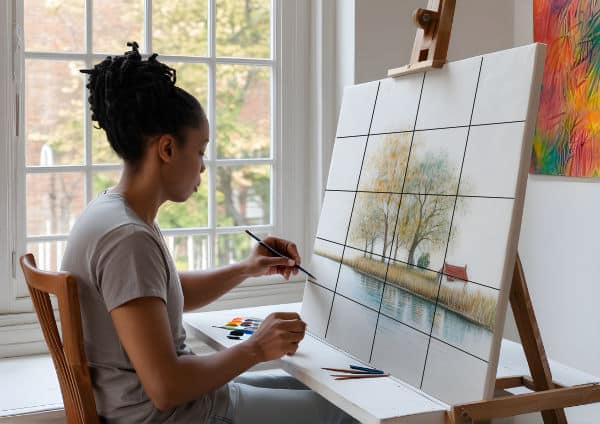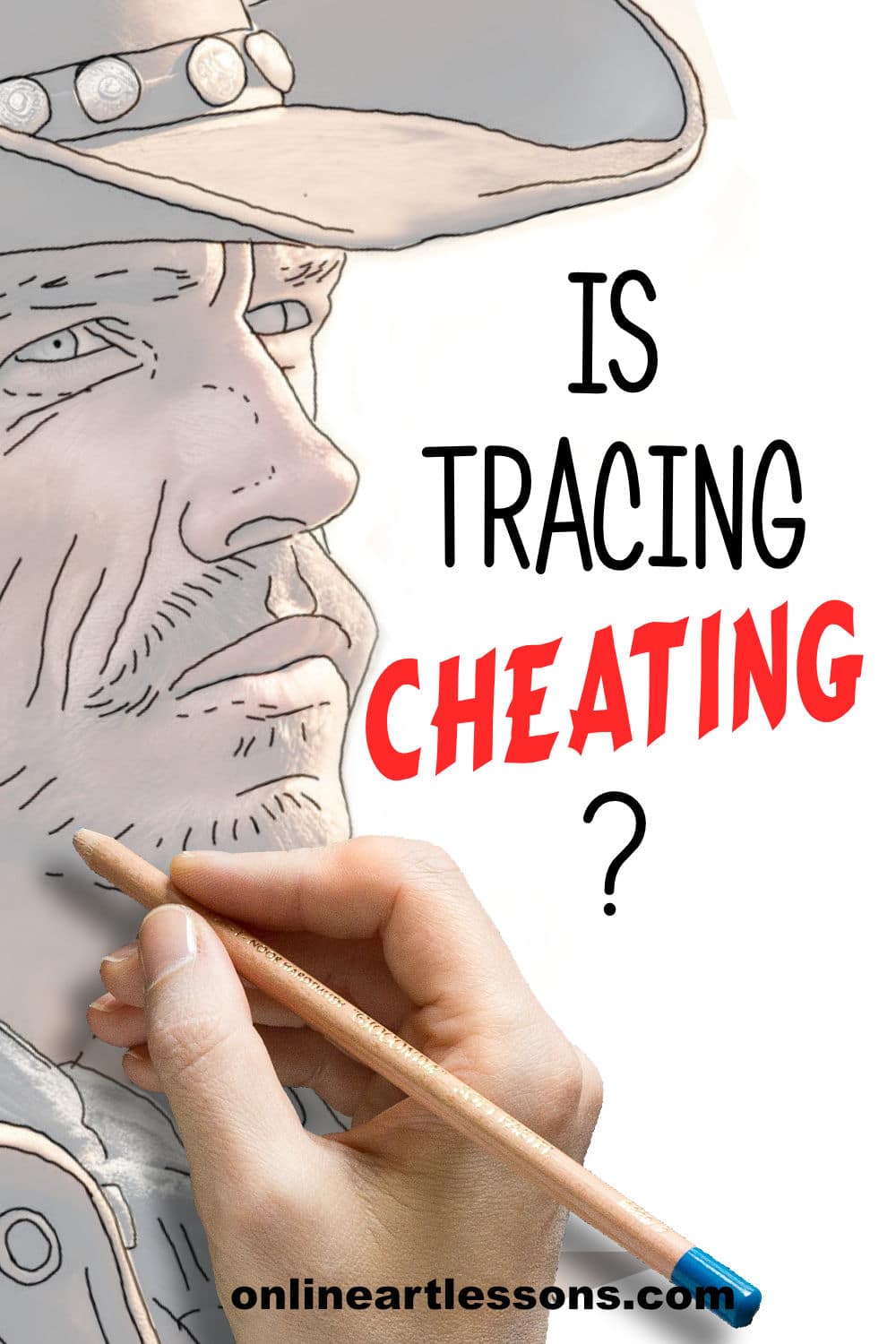The Great Art Controversy:
This question might have crossed your mind more than once if you’ve ever picked up a pencil and felt the urge to create. Tracing is a bit like the art world’s open secret – almost everyone has done it at some point, but not everyone will admit to it.
So, what exactly is tracing?
It’s when an artist copies an image line for line onto their work surface. The most common way to do that is by printing out your reference to the same size as the canvas, then using carbon paper to trace the main outlines of the subject onto the canvas.
Some folks reckon it’s a bit like sneaking a peek at your classmate’s quiz—it gets the job done, but is it really your work? Others argue it’s a legit way to learn and get things rolling, especially when you’re just starting out.
There’s a whole rainbow of opinions on tracing, from “absolutely not” to “why the heck not?” This article isn’t just about whether tracing is good or bad. It’s a look at the big picture: the pros and cons, who’s doing it and why, and some solid alternatives when you’re ready to branch out. And of course, I’ll throw in my two cents about whether I think tracing is a step on the staircase to mastering art or if it’s a step into the abyss. Let’s start our journey towards unravelling this canvas of controversy.
Pro’s & Con’s of Tracing
Let’s weigh in on the pros and cons of tracing. This technique can spark quite the debate, so it’s only fair to lay out what’s good and what’s less than ideal about it. Here’s the rundown:
Pros:
Speeds Up the Process: Tracing lets you fast-forward through the initial drawing phase. It’s quick, it’s easy, and it gets the job done without the stress of starting from scratch.
Accuracy: If you’re aiming for a carbon copy of a design, tracing is your best friend. It delivers a precise rendition of the reference, leaving no room for guesswork.
Volume of Work: More art in less time? Tracing can make you prolific, which is great for building a portfolio or keeping your art feed fresh.
Ease of Use: All you need is something transparent to trace on and something to trace with, and you’re good to go. It’s art made easy.
Learning Tool: For beginners, tracing can be an excellent way to get accustomed to the drawing process, helping to develop hand control and an understanding of lines and shapes.
Cons:
Skill Development: Relying on tracing can hinder the development of freehand drawing skills, such as understanding proportions and observational skills, which are crucial for an artist’s growth.
Over-Reliance: It’s comfy to stay in the tracing zone, but it might hold you back from discovering your true drawing potential.
Creativity: Sometimes, tracing can clip your creative wings. There’s a whole world to explore beyond the traced outlines of a reference image.
Not as Accurate as You Think: Tracing isn’t foolproof. Especially when tracing smaller images with fine detail you will find that small inaccuracies can made a huge difference to the final artwork.
The ‘Cheat’ Debate: And of course, there’s the stigma. In some art circles, tracing is a definite no-no, and just mentioning the T word can get you banished and branded a fake artist forever.
These points reflect a balance between the practicality of tracing as a tool and the potential drawbacks regarding skill development and the perception of authenticity in the art community.

Who Traces & Why
Now, let’s dive into who’s tracing and why. From the classroom to the studio, tracing is more common than you might think, and it’s not just beginners who are doing it.
Amateur Artists: It’s a no-brainer why newbies love tracing. It helps them get started quickly by avoiding the difficult task of drawing accurately. Think of it as the bumpers in a bowling alley – when you start the drawing or painting with an accurate sketch, you can make many mistakes along the way and the final result will still look pleasing.
Professional Artists: Yep, even the pros trace sometimes. Whether it’s to save time on a tight deadline or to nail an intricate design, tracing can be a practical shortcut in a professional’s workflow.
Old Masters: And here’s a fun fact—some of the art world’s big names, like Vermeer and Michelangelo, were no strangers to tracing techniques. They used tools like the camera obscura or pouncing to transfer their masterpieces onto canvas.
Tracing spans the spectrum of artistry, from the student learning the ropes to the master creating a masterpiece. It’s a thread that weaves a common thread through the tapestry of art history, showing us that tracing, in its many forms, has always been part of the picture.
Why is Tracing Considered Cheating?
If so many artists trace why would tracing be considered cheating by so many?
The heart of the matter lies in the traditional view of art as a direct expression of an artist’s creativity, vision and skill. When we think of artists, we imagine them masterfully working away, their hands and eyes in perfect sync as they bring to life images from their minds. In this idealized view, art is a solitary climb to creative mastery, and tracing is seen as taking the lift to the summit.
Historically, art has been a measure of technical skill as much as creativity. The ability to replicate the world around us with accuracy was prized, and those who could do so without aids were revered. In this context, tracing could be considered a shortcut that skips the rigorous discipline of developing your eye-hand coordination and understanding of perspective and proportion.
Moreover, the idea of originality is paramount in the art community. Creating something truly your own is often what separates the “artists” from the “artisans.” Tracing might imply that the work is not entirely the product of an artist’s unique vision, but rather a reproduction.
If we are then not “allowed” to trace, what other options are there for getting the outlines on the canvas?
Tracing Alternatives
Let’s explore some alternatives to tracing that can help artists develop their skills. Each of these techniques encourages a more hands-on approach to understanding and capturing the subject.
Grid: By dividing your reference and your canvas up into grids of equal proportions you can easily reference where to draw your outlines. Learn how to use the grid correctly.
Basic Shapes: Every object is a puzzle made of simple shapes. Artists can build their visual library by breaking down complex subjects into basic geometric forms, which is a cornerstone of learning to draw.
Guidelines: Lightly sketched lines can act as a roadmap on a blank canvas, helping place features and maintain proportions without the need for tracing. These guidelines are not perfectly placed / drawn. They just give you a rough idea of where each item goes on the canvas. Then as you paint you gradually fine tune the placement until it is correct.
Observation: There’s no substitute for good old-fashioned observation. By studying and sketching from life, artists sharpen their eyes, hand coordination, and interpretive skills.
Regular Practice: Like any skill, drawing gets better with practice. Regular doodling, sketching, and drawing can lead to marked improvements over time.
Using References: Working with reference images without tracing them can challenge an artist to understand and replicate the subject, which is a critical skill.
Proportional Divider: This tool helps measure and replicate the proportions of a subject accurately, which can be a valuable stepping stone towards freehand drawing.
These alternatives not only bolster an artist’s ability to create without tracing but also enrich their overall understanding of art and its principles.

My View on Tracing
Now, let’s wrap this up with my view on the matter.
Art is a craft which consists of two distinct parts – creativity and skill.
Both can be learned, but can take a lot of hard work over years to master. To be a good artist you need to master creative thinking, sketching skills, basic shading work, color theory, color mixing, and many other advanced skills. In fact there are more skills for you to learn than you will ever be able to in your lifetime. That is why most professional artists will specialize in one or two subjects using one or two mediums at most.
For a beginner all these skills can quickly become overwhelming causing them to quit. We don’t want that. We want more people to be creative. We want more people to experience the joys that art can bring.
Tracing is a tool – nothing more, nothing less. And like a paint brush and every other tool in the artist’s belt, it’s there to help you build the skills you need. Starting with the basics and moving up to more complex tasks is a natural progression in any craft.
Beginning with tracing can give you a solid starting point while you focus on mastering fundamental techniques like color mixing, shading and blending. As your confidence grows and those learned skills become second nature, you challenge yourself with additional skills.
Tracing becomes using the grid method, then you move on to using a proportional divider, and eventually, freehand sketching on spare paper before transferring it to the canvas. Before you know it you have the ability to accurately sketch freehand directly onto the canvas.
The key is to use tracing as a stepping stone, not a crutch. It’s a part of your artistic journey, not the destination. By understanding its place and purpose, you can utilize tracing effectively and with a clear conscience, while still aiming for the ultimate goal of developing your unique artistic voice.
Having said all that, you don’t HAVE to learn how to sketch. You are the master and you decide what skills you want to learn. If you are happy to quickly trace the outlines onto the canvas so that you can get on to the painting side of the artwork, so be it. It’s perfectly okay! Never let anybody make you feel less competent or guilty for doing what YOU want to do.
You are the artist, you decide which tools you use to create your art!
If you would however like to learn how to sketch freehand, you can follow my Sketchbook Basics Course. That will quickly get you sketching confidently.
Pin Me
